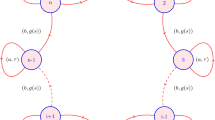Abstract
This paper considers a mathematical model of a ring neural network with an even number of synaptically interacting elements. The model is a system of scalar nonlinear differential-difference equations, the right-hand sides of which depend on a large parameter. The unknown functions being contained in the system characterize membrane potentials of neurons. It is of interest to search within the system for special periodic solutions, so-called impulse-refractory modes. Functions with odd numbers of the impulse-refraction cycle have an asymptotically large burst and the functions with even numbers are asymptotically small. For this purpose, two substitutions are made sequentially, making it possible to study of a two-dimensional system of nonlinear differential-difference singularly perturbed equations with two delays instead of the initial system. Further, as the large parameter tends to infinity, the limiting object is defined, which is a relay system of equations with two delays. Using the step-by-step method, we prove that the solution of a relay system with an initial function from a suitable class is a periodic function with required properties. Then, using the Poincaré operator and the Schauder principle, the existence of a relaxation periodic solution of a two-dimensional singularly perturbed system is proven. To do this, we construct asymptotics of this solution, and then prove its closeness to the solution of the relay system. The exponential estimate of the Frechet derivative of the Poincaré operator implies uniqueness of the solution of a two-dimensional differential-difference system of equations with two delays in the constructed class of functions and is used to justify the exponential orbital stability of this solution. Furthermore, with the help of reverse replacement, the proven result is transferred to the original system.

Similar content being viewed by others
REFERENCES
Glyzin, S.D., Kolesov, A.Yu, and Rozov, N.Kh., On a method for mathematical modeling of chemical synapses, Differ. Equations, 2013, vol. 49, no. 10, pp. 1193–1210.
Glyzin, S.D., Kolesov, A.Yu., and Rozov, N. Kh., Self-excited relaxation oscillations in networks of impulse neurons, Russ. Math. Surv., 2015, vol. 70, no. 3, pp. 383–452.
Glyzin, S.D., Kolesov, A.Yu., and Rozov, N.Kh., Relaxation self-oscillations in Hopfield networks with delay, Izv.: Math., 2013, vol. 77, no. 2, pp. 271–312.
Glyzin, S.D., Kolesov, A.Yu., and Rozov, N.Kh., Discrete autowaves in neural systems, Comput. Math. Math. Phys., 2012, vol. 52, no. 5, pp. 702–719.
Preobrazhenskaia, M.M., Relaxation cycles in a model of synaptically interacting oscillators, Model. Anal. Inform. Sist., 2017, vol. 24, no. 2, pp. 186–204.
Kolesov, A.Yu., Mishchenko, E.F., and Rozov, N.KH., Relay with delay and its C 1-approximation, Proc. Steklov Inst. Math., 1997, vol. 216, pp. 126–153.
Glyzin, S.D., Kolesov, A.Yu., and Rozov, N.Kh., Relaxation self-oscillations in neuron systems: I, Differ. Equations, 2011, vol. 47, no. 7, pp. 927–941.
Glyzin, S.D., Kolesov, A.Yu., and Rozov, N. Kh., Relaxation self-oscillations in neuron systems: II, Differ. Equations, 2011, vol. 47, no. 7, pp. 1697–1713.
Glyzin, S.D., Kolesov, A.Yu., and Rozov, N. Kh., Relaxation self-oscillations in neuron systems: III, Differ. Equations, 2012, vol. 48, no. 2, pp. 159–175.
Kolesov, A.Yu., Mishchenko, E.F., and Rozov, N.Kh., A modification of Hutchinson’s equation, Comput. Math. Math. Phys., 2010, vol. 50, no. 12, pp. 1990–2002.
Preobrazhenskaya, M.M., Existence and stability of relaxation cycles in a neurodynamic model with two delays, Vestn. Mosk. Inzh.-Fiz. Inst., 2016, vol. 5, no. 4, pp. 351–366.
Glyzin, S.D., Kolesov, A.Yu., and Rozov, N.Kh., Modeling the bursting effect in neuron systems, Math. Notes, 2013, vol. 93, no. 5, pp. 676–690.
ACKNOWLEDGMENTS
This work was supported by the Russian Science Foundation (project no. 14-21-00158).
Author information
Authors and Affiliations
Corresponding author
Additional information
Translated by K. Lazarev
About this article
Cite this article
Preobrazhenskaia, M.M. The Impulse-Refractive Mode in a Neural Network with Ring Synaptic Interaction. Aut. Control Comp. Sci. 52, 777–789 (2018). https://doi.org/10.3103/S0146411618070210
Received:
Published:
Issue Date:
DOI: https://doi.org/10.3103/S0146411618070210




